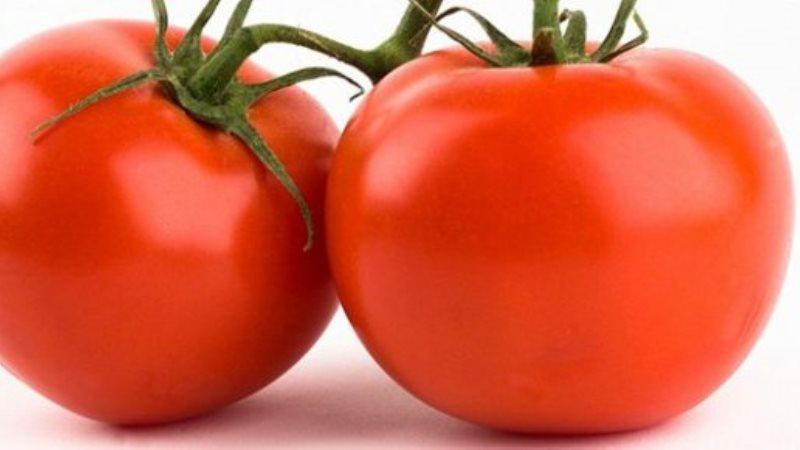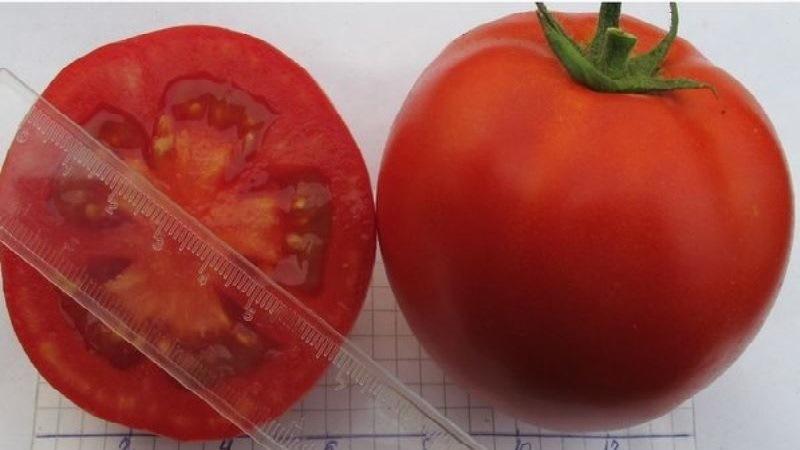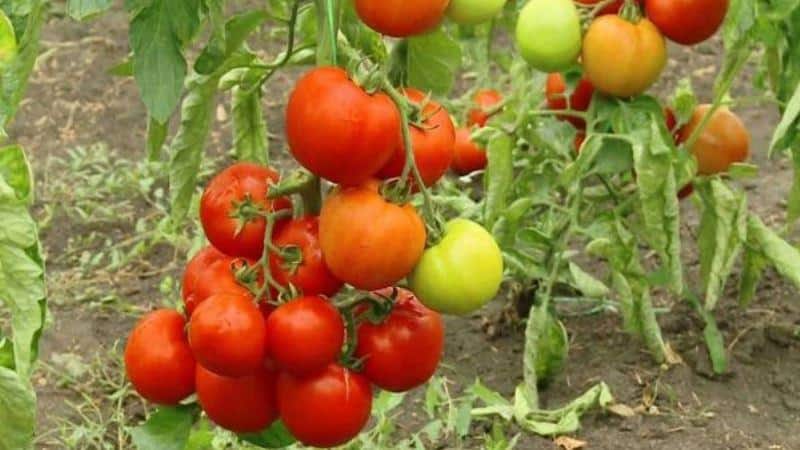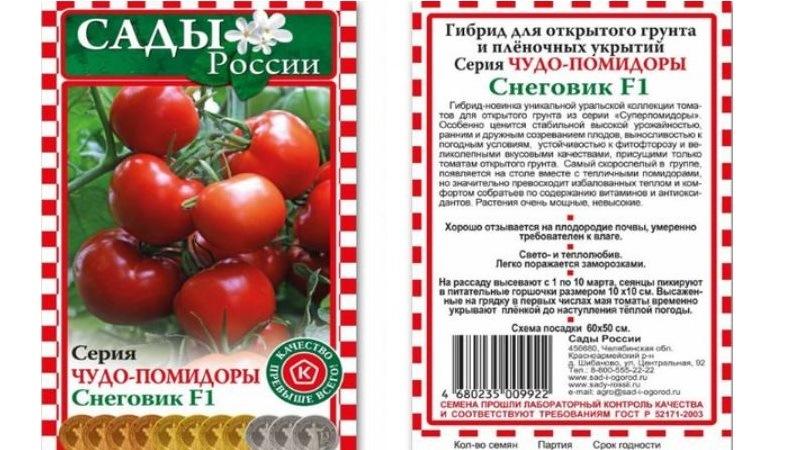Pros and cons of the hybrid tomato Snowman F1
Are you looking for an unpretentious, productive and disease-resistant plant? variety tomatoes? Pay attention to Snowman F1. This is a young, attractive hybrid that even a novice gardener can grow.
Origin of the variety
Tomato Snowman F1 is a hybrid variety bred by Russian breeders. Included in the state register of varieties in 2007. The variety belongs to the category of first generation hybrids.
The plant is intended for cultivation in open ground in the Volga-Vyatka, Far Eastern and Ural regions. In colder areas it is recommended to grow tomato in greenhouse shelters.

Characteristics and description of the variety
Variety Snowman F1 - early ripening. From the moment of seed germination to the ripening of the first fruits, 85-90 days pass.
The plant is determinate. In open ground, the height of the central stem is 50-70 cm; in greenhouses, the tomato grows up to 120 cm. The leaves are medium-sized, dark green.
The fruits are flat-round with slightly pronounced ribbing. Ripe fruits have a thin, glossy skin and acquire a bright red color. The pulp is of medium density consistency with 4-6 seed chambers. The weight of tomatoes varies from 60 to 120 g. The tomato has a sweet and sour pleasant taste and pronounced aroma.
The yield of the variety is above average. Up to 4-5 kg of ripe fruits are collected from one bush. Ripe tomatoes are used both fresh and for processing and canning.
Pros and cons of the variety
Let's consider the advantages and disadvantages of the variety we are considering.
Advantages:
- resistance to major nightshade diseases;
- high percentage of fruits of commercial size and quality (up to 90%);
- unpretentiousness. The tomato tolerates both drought and heat, as well as low air temperatures;
- fruits tolerate transportation well;
- Suitable for growing both in open ground and in greenhouses.
Among the disadvantages of the variety, we only note the need to purchase seeds annually, since the hybrid variety does not allow you to prepare the seeds yourself.
How to grow a tomato
Let us tell you in detail about growing our “snowman”.
Seed preparation
They begin to grow seedlings of early ripening varieties 35-45 days before the expected date of planting the plant in a greenhouse or open ground.
Note. Don't worry if you're a little late with sowing. Solar activity increases as summer approaches, and seedling growth occurs faster; the seedlings will have time to develop sufficiently and will not outgrow.
Before planting seeds for germination, they undergo preparatory treatment: heating and soaking.
Two weeks before planting, place the seeds in a warm, dry place so that they warm up well. It is most convenient to place the seeds near heating appliances. The procedure imitates the natural process of spring warming up and triggers an “awakening”.
Immediately before sowing, the seeds are soaked in growth stimulants for several hours. This will speed up germination and make the future plant stronger and more resistant to adverse environmental factors.
Important! During the soaking process, some seeds will float. They must be removed and not used for sowing.
It is not necessary to disinfect the seeds, since all seeds are disinfected before going on sale.

Sowing
A 1.5-2 cm thick drainage layer of expanded clay is placed at the bottom of the planting container. A 5-6 cm layer of soil is poured on top. Tomatoes prefer neutral, slightly acidic soil. Both ready-made and self-prepared soils are suitable for planting.
To place the seeds in the ground, prepare small grooves, about 1 cm deep. The soil is well moistened with a spray bottle. Then, at a short distance from each other, the seeds are laid in rows and sprinkled with dry soil on top. The top soil is slightly compacted. The container is covered with film and placed in a warm place.
The optimal air temperature is 24-25°C. If the temperature is not maintained, the seeds will germinate more slowly.
Important! Compared to varietal tomatoes, hybrid tomato seeds are more demanding of heat.
After the first shoots appear, after about 5-7 days, the film is removed from the container.
Growing seedlings
Approximately 14-20 days after the appearance of the first shoots, the sprouts are planted in individual containers. By this time, the plant has two true leaves.
The seedling is dug up with a teaspoon and transferred to a container along with a lump of earth. The soil around the transplanted plant is well compacted so that no voids are formed, and it is shed. Sprinkle dry soil on top and do not water again. Next watering required as the earthen coma dries out after 3-5 days.
Once every 2-3 weeks, seedlings are fed with phosphorus-potassium fertilizers.
If tomatoes grow in open ground, then hardening begins 1-2 weeks before planting.To do this, the seedlings are briefly exposed to cold air and open sun every day. The first time this is done for 15 minutes. Every day the stay time is gradually increased. The optimal temperature for hardening is from +12 to +15°C.
Landing
As soon as the earth has warmed up to 12-14°C, and the likelihood of night frosts is minimal, the tomatoes are planted in a permanent growing location. The soil is treated with a solution of potassium permanganate for disinfection 1 week before planting.
To ensure uniform lighting and ventilation of the plant, leave 50-60 cm between the bushes.
2-3 days before planting, preparation of planting holes or furrows begins. Nitrogen-free fertilizer is applied to the planting hole (or furrow) (for example, 2 tablespoons of “Borofoska”; the fertilizer will slowly dissolve throughout the summer). Next, they are spilled with solutions of “Fitosporin” with “Baikal” or “Trichodermin” with “Baikal”. On the day of planting, the holes are once again shed with warm water.
Before planting, the seedlings are not watered for 2-3 days so that the earthen ball dries out a little. This will make it easier to remove the plant from the container without damaging it.
When planting, the seedling is placed in a hole or groove at an angle of 45 degrees, covered with earth and compacted well to prevent the formation of voids. The earth is once again watered with water from a watering can (calcium nitrate can be added to the water at the rate of 1 tablespoon per 10 liters) and sprinkled with dry earth on top.
Important! The next watering after transplanting the plant is done no earlier than 7-10 days later. This will allow the plant to form a more extensive root system.
Watering
Tomatoes do not like waterlogged soil or excessive watering; once a week will be enough.It is best to water in the morning, then during the day the plants will have time to absorb excess moisture, and at night the roots will not become overcooled.
To prevent the formation of a hard crust on the surface of the earth, the soil around the stem should be loosened regularly. The sharp edges of the peel leave microdamages on the delicate skin of the shoot, through which pathogens and bacteria enter the plant.
Bush formation, pinching
Tomato Snowman F1 is determinate, so the bush is formed into 2-3 stems. Before the first cluster is formed, the plant is grown in one stem. All stepsons and leaves are removed. After the first brush, up to 2-3 strong stepsons are left. The main harvest will be formed on these branches.
Advice. When breaking out a stepson, leave a stump 3 cm long. It will prevent a new stepson from forming in the leaf axil for a long time.
Top dressing
Hybrid tomato needs weekly feeding. For different growth phases, the plant requires different ratios of minerals. For root feeding, the following fertilizer ratios are used:
| Type of fertilizer, grams | |||
| Growth phase | Ammonium nitrate | Superphosphate | Potassium chloride |
| Immediately after disembarkation | 15 | 45 | 5 |
| Until 3 brushes appear | 25 | 70 | 20 |
| Until the end of fruiting | 30 | 30 | 25 |
All dosages are indicated per 10 liters of water.
Monitoring your tomatoes will allow you to adjust the application of fertilizers. With the intensity of growth of green mass, the plant “fattens” and does not bloom. In this case, the amount of ammonium nitrate should be reduced, and the dosage of potassium and phosphorus (superphosphate) should be increased.
Prevention of diseases and pests
Like many hybrid varieties, Snowman is resistant to the most common diseases Solanaceae (to mosaic and bacterial leaf spot, as well as to root and apical rot). Due to the early ripening period, the tomato has time to produce its fruits before the onset of massive development of late blight.
Despite the plant’s immunity, violations of the rules of agricultural technology can weaken it and reduce the possible yield.
Basic mistakes in caring for tomatoes:
- plants planted too close;
- excessive watering, in which the earthen ball does not have time to dry out;
- the formation of a hard crust on the surface of the earth, which prevents the flow of oxygen to the roots;
- high air humidity in the greenhouse (more than 60%);
- lack of nutrients.
If you still encounter difficulties, these tips will help you:
- Fungicides will help combat bacterial infections. They are of chemical or biological origin. Biological: “Ecosil”, “Fitosporin”. Chemical: “Ridomil”, “Bordeaux mixture”;
- Insects are dealt with by spraying with odorous liquids, for example, tincture of chamomile, celandine or garlic;
- aphids are easily washed off with a simple soap solution.

Reviews from gardeners
Gardeners who have already tried to grow Snowman note in their reviews of tomatoes of this variety:
- good taste of fruits;
- abundant and long-lasting fruiting;
- high percentage of beautiful tomatoes;
- ripe tomatoes correspond to the characteristics and photos declared by the manufacturer;
- fruits tolerate transportation well;
- picked fruits are stored for a long time without losing their taste.
Conclusion
The unpretentious and productive variety Snowman F1 is perfect not only for experienced gardeners, but will also delight novice gardeners with its qualities.It is resistant to diseases, bears fruit early and does not require special attention. It is enough to provide it with timely watering, removal of weeds, loosening the soil, and the plant will thank you with a bountiful harvest.
Tomatoes are well stored and transported. It’s definitely worth trying to grow this variety in your garden.
